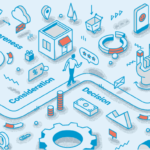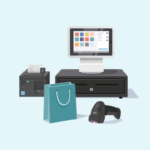As the line between online and offline shopping continues to blur, personalizing the shopping experience across in-store and e-commerce channels pays off. With highly personalized customer experiences, retailers not only create a differentiator that’s difficult for competitors to replicate. They also see a revenue increase of 5 to 15 percent.
How personalized retail works in real-life
Here’s an example of an integrated, personalized retail experience in action. Sandra Shopper visits a physical store location. When asked if she needs help, she mentions an interest in a new clothing line that the store recently added. The sales associate asks a few questions to understand Sandra’s needs and helps her choose a few items. Sandra is delighted by the sales associate’s knowledge about the clothing line and the personalized recommendations based on their conversation. She makes a purchase.
Throughout the shopping experience and at checkout, the sales associate accesses the point-of-sale (POS) system via a tablet, seamlessly referencing and adding to or creating the customer’s profile. After Sandra Shopper leaves the store, she receives a personal email from the sales associate thanking her again for her purchase. The message includes a discount offer for her next purchase, whether in-store or online. A few weeks later, Sandra visits the store’s e-commerce site and purchases some additional items using her discount code.
The experience doesn’t end there. Over the next several months, Sandra Shopper receives customized communications from the retailer. Based on her purchases and preferences, Sandra is alerted to new items she might like, upcoming promotional events, and special offers for select customers. Some – but not all – of the communications include discounted offers. Sandra becomes a loyal customer, regularly shopping both in-person and online.
Omnichannel shopping experiences keep customers like Sandra engaged and pay off big for retailers who are able to pull them off. Research by McKinsey & Company shows that positive customer experiences boost customer satisfaction rates by up to 20 percent and sales conversion rates by 10 to 15 percent.
So, how can you harness the power of personalization for your retail business? Start with this checklist.
POS personalization checklist for retailers
1. Data first
Successful personalization strategies begin and end with your POS system and your ability to capture, compile, and access valuable data points. With customers interacting with their favorite retailers online, via mobile, and in-store – often using all access points during the course of making a single purchase – you must choose a POS system that integrates your data collected across channels in real-time.
Related: Turn Your Retail Data into a Competitive Advantage
2. Put your POS data to work
Today’s customers expect retailers to capture – and use – personalized data. Eighty-three percent of consumers say they’re willing to share data in exchange for a more personalized experience. Your POS system must do more than aggregate your data. It must also make it usable, both in-person and online.
In-store, leverage your POS system’s profile and mobile capabilities to put relevant customer details, purchase history, and inventory info at your sales associates’ fingertips, no matter where they are in the store. Online, use data points, such as previous purchases and customer loyalty program status, to make personalized suggestions as customers browse and buy.
3. Inventory in real-time
Delivering an omnichannel shopping experience is next to impossible if your inventory management is siloed. Make sure your POS system enables you to integrate inventory tracking and analysis across channels, giving you an up-to-the-minute view of what’s on store shelves, what’s been ordered online, and what’s in the warehouse. Build automated reports so you’re always aware of large orders, best sellers, and poor-performing items. And tap into your POS system’s capabilities to build in automated reorder triggers to ensure you never run out of in-demand items.
Related: Omnichannel Inventory: Avoid These 3 Obstacles
4. Tailor marketing outreach
Make the most out of your POS data by creating targeted, personalized marketing campaigns. Identify segments of customers based on purchases, spending level, and product preferences. Then, develop tailored marketing messages and promotional offers. Targeted marketing examples include welcoming new customers, keeping your best customers engaged with regular outreach, and re-engaging customers who haven’t purchased in a while.
5. Analyze and repeat
Your POS system should integrate customer data across brick-and-mortar and e-commerce channels to create a single source of information. But too much data can be overwhelming. Spend time identifying the essential data points to deliver an optimal customer experience and track your progress toward business objectives. Then, create automated standard reports that keep you up to date on key sales, customer metrics, and inventory metrics.
Does your POS system give you the power to personalize? POSIM is a point-of-sale and inventory management system designed to centralize your data across channels and make delivering personalized retail experiences easy. Contact us for a demo to see what POSIM can do for your business.












